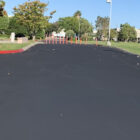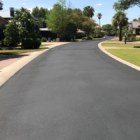Asphalt sealcoating is essential for protecting asphalt surfaces from the damaging effects of water, sunlight, and chemicals. By applying a sealant, the pavement becomes more resistant to water penetration, which helps prevent cracking, potholes, and other forms of deterioration. Sealcoating also provides a protective barrier against oxidation from sunlight and reduces the risk of damage from oil and gasoline spills. Additionally, it enhances the appearance of the pavement, giving it a fresh, dark finish, and extends the lifespan of the asphalt, ultimately saving on long-term maintenance costs. Overall, asphalt sealcoating is a crucial preventive maintenance measure that preserves the structural integrity and appearance of asphalt surfaces.
The frequency of parking lot striping depends on various factors such as the amount of traffic, weather conditions, and the type of paint used. In general, parking lot striping is typically recommended every 1-2 years to maintain clear and visible markings, especially in high-traffic areas. However, in regions with harsh weather conditions or heavy traffic, more frequent restriping may be necessary to ensure safety and organization. Additionally, regular inspections can help determine when striping is needed, as faded or worn markings can create confusion and safety hazards. Ultimately, the frequency of parking lot striping should be based on the specific conditions and usage of the parking lot.
The best time for sealcoating in Little Rock, Arkansas, is typically during the late spring or early summer months when the weather is consistently warm and dry. This allows the sealant to properly cure and adhere to the asphalt surface. Avoiding periods of high humidity, excessive heat, or heavy rainfall is crucial to ensure the sealcoating process is effective. It’s also important to consider the specific weather conditions and temperature requirements recommended by the sealcoating product manufacturer for optimal application and performance. Additionally, scheduling sealcoating during periods of lower traffic can minimize disruptions and allow ample time for the sealant to set and cure undisturbed.
Asphalt crack filling is necessary to prevent water, debris, and other harmful substances from infiltrating the pavement and causing further damage. By filling cracks, the structural integrity of the asphalt is preserved, reducing the likelihood of potholes, rutting, and other forms of deterioration. This maintenance practice helps to extend the lifespan of the pavement, minimize the need for costly repairs, and enhance safety for vehicles and pedestrians. Additionally, crack filling can improve the overall appearance of the pavement, contributing to a well-maintained and professional-looking surface. Therefore, asphalt crack filling is an essential preventive measure to protect and maintain the quality of asphalt surfaces.
Power washing, also known as pressure washing, involves using a high-pressure water spray to clean and remove dirt, grime, mold, mildew, and other contaminants from surfaces such as buildings, vehicles, concrete, and outdoor areas. The forceful stream of water generated by power washing equipment is effective in lifting and removing stubborn stains, dirt, and debris from various surfaces, restoring their cleanliness and appearance. Power washing is an efficient and versatile cleaning method that can be used for a wide range of applications, from removing grease and oil from driveways to cleaning exterior walls and preparing surfaces for painting or sealing. It is an effective way to maintain and revitalize surfaces, enhancing their visual appeal and prolonging their longevity.
Asphalt repair typically involves several steps, starting with an assessment of the extent of damage, which may include cracks, potholes, or surface deterioration. The damaged areas are then cleaned of debris and loose materials, and any necessary repairs or patching are carried out. This may involve filling cracks, applying patching materials, or removing and replacing severely damaged sections of the asphalt. Once the repairs are completed, the surface is typically leveled and compacted to ensure proper alignment and stability. Finally, a sealant or topcoat may be applied to protect the repaired areas and provide a uniform finish. Overall, the process for asphalt repair aims to restore the structural integrity and functionality of the pavement, addressing specific areas of damage to prolong its lifespan and maintain safety and usability.
Asphalt pavement should ideally be sealed approximately six months to one year after installation to allow for proper curing, and then every two to three years thereafter, depending on the condition of the pavement and the level of wear and tear. However, it’s important to consider the specific climate and usage of the pavement. Sealcoating during dry, warmer weather is preferable to ensure proper adhesion and curing of the sealant. Additionally, scheduling the sealcoating during periods of lower traffic can minimize disruptions and allow ample time for the sealant to set and cure undisturbed. Regular inspections can help determine when sealcoating is needed, as faded or worn surfaces may benefit from earlier application. Ultimately, the decision to seal asphalt pavement should be based on its condition, age, and the specific environmental and usage factors affecting it.
Yes, it is recommended to repair potholes before sealcoating. Potholes are a sign of significant pavement damage and can compromise the effectiveness of the sealcoating if left unaddressed. Repairing potholes involves filling and patching the damaged areas to restore the structural integrity of the pavement. By addressing potholes before sealcoating, the overall longevity and performance of the pavement can be improved, as the sealant will be applied to a more stable and even surface. Additionally, repairing potholes helps prevent further deterioration and ensures a smoother, more uniform finish after sealcoating, contributing to the overall effectiveness of the maintenance process.



